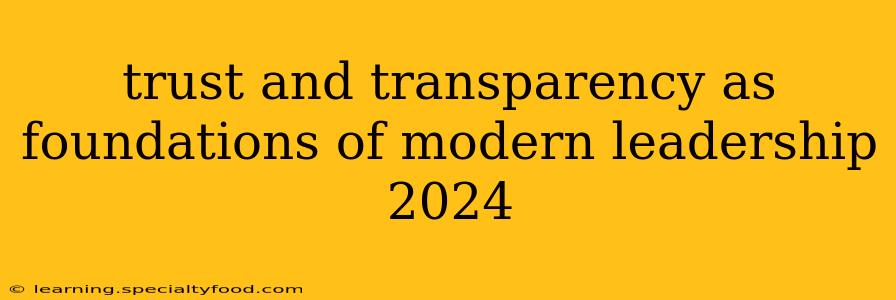The landscape of leadership is constantly evolving, and in 2024, trust and transparency are no longer optional—they're fundamental cornerstones for effective leadership. In a world saturated with information and increasingly skeptical audiences, leaders who prioritize open communication and build strong relationships based on trust are best positioned to thrive. This article explores the crucial role of trust and transparency in modern leadership, examining their impact on various aspects of organizational success.
Why are Trust and Transparency Crucial for Leaders in 2024?
The modern workforce demands authenticity and accountability from their leaders. Millennials and Gen Z, now significant portions of the workforce, value transparency and open communication above all else. A lack of trust erodes morale, productivity, and ultimately, the bottom line. Transparency fosters a culture of collaboration, innovation, and psychological safety, allowing employees to feel valued and empowered. In 2024, the reputational risks associated with a lack of transparency are substantial, potentially leading to decreased investor confidence, damaged brand image, and legal repercussions.
How to Build Trust and Transparency in Your Leadership Style
Building trust and transparency requires a conscious and consistent effort. It's not a one-time fix but an ongoing process of cultivating relationships and demonstrating integrity.
1. Lead with Authenticity:
Authenticity is the bedrock of trust. Be genuine in your interactions, admit mistakes, and be vulnerable when appropriate. Employees can spot inauthenticity a mile away, and it will undermine any attempts at building trust.
2. Foster Open Communication:
Establish clear and consistent communication channels. Encourage open dialogue, feedback, and questions. Regular town halls, team meetings, and accessible leadership are all effective ways to foster open communication. Avoid information silos; ensure everyone has access to relevant information.
3. Be Accountable:
Take responsibility for your actions and decisions, both successes and failures. Avoid shifting blame and instead, focus on solutions and learning from mistakes. Accountability demonstrates integrity and builds trust with your team.
4. Promote Psychological Safety:
Create a work environment where employees feel safe to speak up, share ideas, and express concerns without fear of retribution. This requires actively listening to feedback, valuing diverse perspectives, and addressing concerns promptly and fairly.
5. Demonstrate Ethical Behavior:
Integrity is paramount. Lead by example, adhering to the highest ethical standards in all your interactions. This includes transparency in decision-making processes, fair allocation of resources, and a commitment to ethical business practices.
What are the Benefits of Trust and Transparency in Leadership?
The benefits of prioritizing trust and transparency are numerous and far-reaching:
- Increased Employee Engagement and Morale: When employees trust their leaders and feel valued, they are more likely to be engaged and motivated.
- Improved Productivity and Performance: A culture of trust fosters collaboration and innovation, leading to improved productivity and overall performance.
- Stronger Company Culture: Trust and transparency create a positive and supportive work environment where employees feel connected and valued.
- Reduced Employee Turnover: Employees are more likely to stay with an organization where they feel trusted and respected.
- Enhanced Reputation and Brand: A transparent and trustworthy organization attracts and retains top talent and builds a strong reputation with customers and investors.
How Do I Handle Difficult Conversations With Transparency?
Difficult conversations are inevitable. The key to handling them transparently is preparation and a focus on empathy and understanding. Clearly articulate the issue, listen actively to the other person's perspective, and approach the conversation with a focus on finding a mutually beneficial solution. Prioritize honesty and avoid sugarcoating the truth.
What are the Consequences of a Lack of Trust and Transparency?
Conversely, a lack of trust and transparency can lead to:
- Decreased Employee Morale and Engagement: Employees feel undervalued and distrustful, leading to decreased productivity and job satisfaction.
- High Employee Turnover: Employees seek out organizations where they feel valued and trusted.
- Damaged Reputation and Brand: A lack of transparency can damage an organization's reputation and lead to negative publicity.
- Increased Legal and Regulatory Risks: Lack of transparency can lead to legal and regulatory violations.
- Reduced Investor Confidence: Investors are less likely to invest in organizations that lack transparency.
In conclusion, trust and transparency are not merely buzzwords in modern leadership; they are essential components of success in 2024 and beyond. Leaders who prioritize open communication, accountability, and ethical behavior will build strong, engaged teams, enhance their organization's reputation, and achieve lasting success. By cultivating a culture of trust and transparency, leaders can navigate the complexities of today's business environment and create organizations that are both thriving and resilient.
